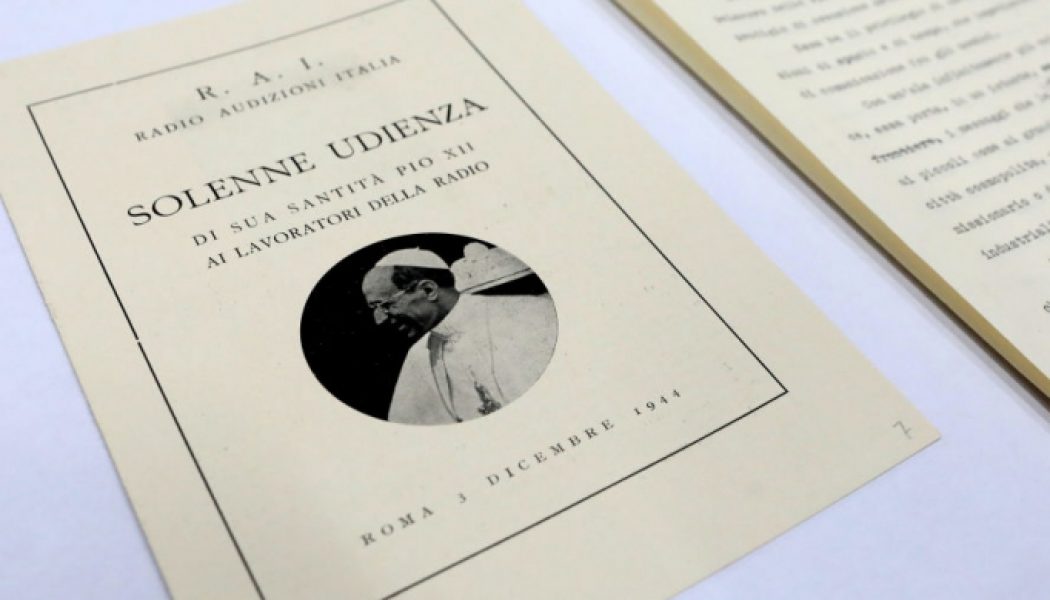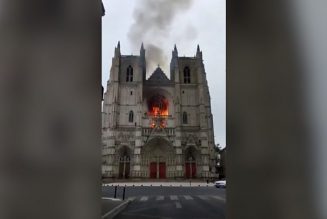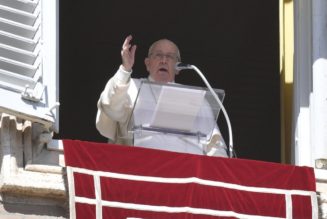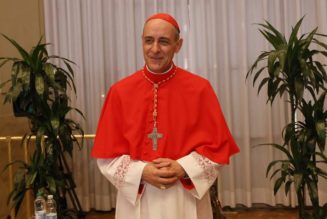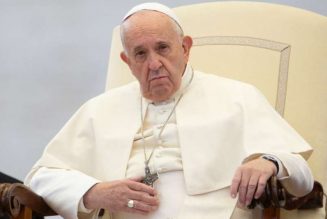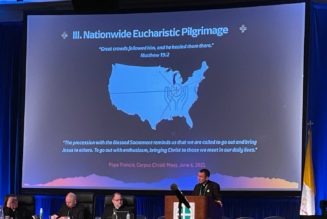
Documents on the pontificate of Pope Pius XII are seen at the Vatican Secret Archives on Feb. 27 in Vatican City. On March 2, the Vatican Apostolic Library opened the Holy See’s wartime archives on the pontificate of Pope Pius XII between the years 1939 to 1958. (Franco Origlia/Getty Images)
Most attention has focused on what they might reveal about the Pope’s actions and attitudes toward the Jews during World War II, but a Vatican conference ahead of today’s opening highlighted other areas of interest.
VATICAN CITY — The Vatican today opened archives relating to Pope Pius XII’s pontificate, and as historians and researchers begin to scour some 2 million documents for information, most attention will be paid to what they reveal about Pius’ actions and attitudes toward the Jews and the Nazis during the Second World War.
But it is what is disclosed about other historical matters that might ultimately be more significant.
Historians and commentators on both sides of the so-called “Pius Wars” debate have long wished for the archives to be opened to know what really happened during those tumultuous years and whether or not Pius did enough to oppose the Nazis and help the Jews.
But a good deal of the documentation during that time has already been released to the public that — according to those who unearthed it, such as Gary Krupp, founder of the Pave the Way Foundation — is sufficient to quash speculation over Pius XII’s war record and just needs to be consulted.
Equally if not more interesting, therefore, will be what new information the documents reveal about other events of a pontificate that stretched from 1939 to 1958 — a “complex and dramatic” period, the Vatican said on Saturday, in which “disputes and turmoil were born in the Church and society that would develop in the following years.”
A Feb. 21 Vatican conference for archivists on the opening of the collections gave some clues to what these documents contain, and one of the most interesting is related to the collections belonging to the Congregation for the Doctrine of the Faith (CDF), then known as the Holy Office.
In a general overview, Msgr. Alejandro Cifres, director of the CDF’s archives, began by noting that “the great themes” confronted by the Second Vatican Council, which became “central to the life of the Church” in the post-conciliar period up until today, “had in large part been anticipated during the Pacelli pontificate.”
“The topics in some cases are very modern,” he continued, adding that “this consideration alone explains why the opening of the pontificate’s archives has great importance for contemporary historiography.”
Responses to Dubia
Of particular interest were dubia (doubts) submitted to the Holy Office during the Nazi era for clarification relating to gravely immoral practices now legalized, or becoming legalized, in the West.
These included euthanasia in Nazi Germany (1940) as well as abortion in occupied France (1942), artificial insemination in Nazi Germany (1944) and forced sterilization during the Nazi regime (1940). Msgr. Cifres said there was even a dubium submitted on the Church’s position on “sex-change operations,” but he later clarified that this occurred after the Nazi era.
The submission of dubia is an ancient procedure, asking the Vatican for simple Yes or No responses to issues relating to Church doctrine. Msgr. Cifres did not say how the Holy Office ruled on these questions, but given the Church has always considered them gravely immoral, it can be supposed the response was always negative.
Msgr. Cifres said other dubia concerned relations of the Church and clergy to Christian denominations and other religions and noted that “attention to Freemasonry naturally remained constant.”
Other recurring dubia regarded how to deal with “schismatic clergy,” including married clergy who wished to be welcomed or return to the Catholic Church, as well as “intercommunion” — to what extent Catholic priests and laity could assist and participate in non-Catholic ceremonies and vice versa.
Msgr. Cifres, who did not say how the Holy Office ruled on these cases, mentioned one in particular: a request made by King Umberto II, the last king of Italy, to attend the “wedding of his Protestant niece, who was baptized Catholic but educated in the schism.”
Other dubia related to questions during the war about whether Catholic churches in occupied France, Italy and other war-affected countries were allowed to be used for Protestant worship and whether priests could provide spiritual assistance to Protestant internees or prisoners. After the war he said “particular concern” was raised “about racist ideas that had survived among the German-speaking minorities in Brazil.”
Notable Catholics
Msgr. Cifres highlighted dossiers in the archives on various Catholics noted for their social and political activities during a time of war and in the post-war period. One hero was Don Paolo Liggeri (1911-1996), who, having spent time in Nazi concentration camps for having given refuge to Jewish families, dedicated his life to the defense of the family.
Another dossier focused on Canadian-American priest Charles Edward Coughlin (1891-1979) who used a radio program and a newspaper called Social Justice to foster anti-Semitism and support for the policies of Hitler and Mussolini. Both his program and newspaper were eventually banned by the Roosevelt administration.
Although Msgr. Cifres said documents dealt directly with the “intermingling of religion and politics” and included the Church’s relations with totalitarian regimes during the war and afterward, such as the spread of communism and the fight against it and various “political problems” in Europe, the U.S. and Argentina, he did not give details on what those contained.
Other documents, he said, covered “various moral challenges posed by sociological and anthropological change” following the trauma of war and were “not alien to the interests of the Holy Office in these years.” Family relationships, sport, clothing and fashion were among the subjects raised.
A somewhat curious finding under the heading “Christian and profane art” recorded “fierce criticism” of the Italian government’s decision in 1950 to commission Spanish artist Salvador Dali to illustrate Dante’s Divine Comedy, with the critics calling it “disgraceful” to entrust the task to a Spaniard and not to an Italian.
The Index of Prohibited Books
Also in the archives are details of the “Index” of prohibited books (the Index Liborum Prohibitorum was a list of books forbidden by the Church as dangerous to the faith or morals until Paul VI scrapped the list in 1966) and a decision to take a more prudent attitude toward those that were widely distributed: that even though they might be considered “worthy of censorship,” not to include such titles in the “Index” would avoid attributing “to the text and the author greater importance than they deserve.”
Instead, Msgr. Cifres said the Holy Office preferred to procure the “withdrawal” of these copies from circulation, “preventing possible reprints and entrusting ordinary people with the task of warning readers.”
Nevertheless, the entire works of authors Alberto Moravia, André Gide and Jean-Paul Sartre were all included in the “Index” during Pius’ pontificate, while requests were made to remove Blessed Antonio Rosmini from the list. Msgr. Cifres mentions that not all agreed with the removal: A priest from Belluno, Italy, called Albino Luciani, later to become Pope John Paul I, denounced a pamphlet being circulated in the diocesan seminary proposing a revision of the Post Obitum decree that put some of Rosmini’s works on the “Index.”
Meanwhile the Holy Office began, the monsignor said, to “pay attention” to authors such as Yves Congar, Henri-Marie de Lubac, Hans Urs von Balthasar and Jacques Maritain, who were influential during the Second Vatican Council several years later. But Msgr. Cifres said “the focus” was on the works of Ernesto Buonaiuti (1881-1946), excommunicated in 1925 for his defense of modernism. The Holy Office also examined the works of the French philosopher and theologian Jean Guitton (1901-1999), whom Paul VI would later appoint as the first lay auditor of the Second Vatican Council.
Msgr. Cifres said the Holy Office was also “particularly sensitive” to publications related to fascism.
The “nation that aroused most interest” for the dicastery during that period was “certainly France,” he continued, because of “new doctrinal currents and evolutionary trends” that were “developing beyond the Alps.” The Holy Office would make a series of denunciations, beginning with Jesuit Father Marcel Bith, and would continue to monitor the writings of Jesuit Father Teilhard de Chardin, an idealist philosopher whom the dicastery had been examining since 1931. The Holy Office would later issue a monitum, or simple warning, in 1962 against uncritical acceptance of his ideas, the main one being that man is evolving, mentally and socially, toward a final spiritual unity.
The Holy Office also studied other problematic texts coming from France, including a “progressive Catechism” and French publications such as La Croix, Esprit, Temps Present and La Quinzane. The peace movement Pax Christi was also studied because of its “possible links with Communist thought.”
Marian Apparitions
Lastly, Msgr. Cifres highlighted documents from the archives pertaining to Marian apparitions, visions, stigmatizations and cases of false mysticism. He said “particularly noteworthy” was that the “alleged Marian apparitions” were “very high in number,” numbering “almost 40 during the pontificate, an average of two per year.”
Italy had the most, with 16 cases, followed by six in Germany, two in the United States, two in France, three in Belgium, two in Czechoslovakia and one each in Ireland, Luxembourg, Portugal and Romania.
“Curiously enough, there were no cases from Spain or Ibero-American countries,” he said. In most cases, the Holy Office simply “took note” of the alleged apparitions.
He said plenty of documentation exists concerning the Assumption of the Blessed Virgin Mary, which Pius XII promulgated as a dogma in 1950, but that it is “very disorderly” and still requires some reordering, although most can be consulted. Half the documentation, he said, contains “petitions from all over the world in favor of the dogma’s promulgation,” but it had been collected “without homogeneity” and consists of “folders, bound volumes and loose sheets.”
In a statement issued to journalists by email on Feb. 29, the Vatican Apostolic Archives said the Holy See will be able to host “60 researchers daily,” and reservations have already been made up until May and June.
“Pius XII met an enormous number and variety of people, not only in the Holy Year of 1950,” the statement said. “In 1952 almost half a million people were received in audiences: war orphans and amputees, farmers, miners, sportsmen, journalists, sports psychologists, doctors, artists and astronomers.
“In order to offer everyone a comprehensible and stimulating message, the Pope meticulously prepared his speeches, which still today are striking for their very high deontological, technical and scientific level.”
This aspect of Pius’ “intellectual versatility and pastoral sensitivity,” the statement said, could also be “studied in detail in the archival collections, now made available for scholars to consult.”
Edward Pentin is the Register’s Rome correspondent.
